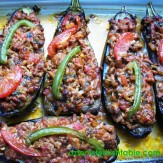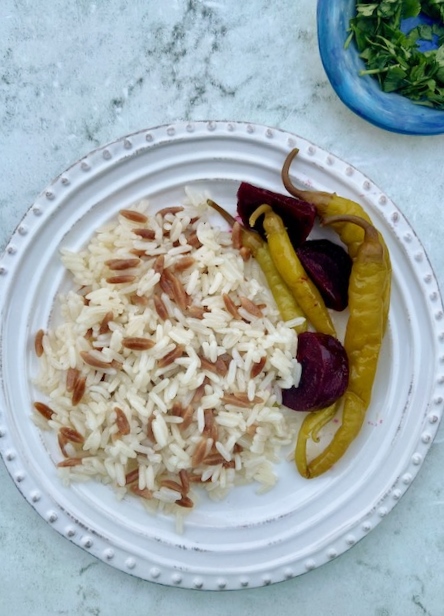
Nohutlu Pilav has been popular since the Ottoman period, and often meat or chicken was included in the pilaf. Tavuklu Nohutlu Pilav is very popular throughout İstanbul as a street food, offered with pickles, turşu, as well as our yoghurt drink, ayran. You may also come across in our no-frills esnaf lokantası restaurants. It is a nourishing meal on its own that I love to eat, with a refreshing salad or pickles aside. Chicken breast is traditional to use, though I prefer to use more flavorful chicken thighs. You can also use up your leftover chicken roast in this pilaf, for another satisfying meal. For vegetarian option, omit the chicken and use water or vegetable stock to cook, as I have done in my cookery book, SEBZE. We have a vibrant street food scene at my homeland Türkiye and there is a whole chapter of street food with doable recipes in SEBZE, copies can be ordered worldwide here.

I hope you enjoy Tavuklu Nohutlu Pilav, Afiyet Olsun,
Ozlem
- 800g/1lb 12oz chicken thighs with bone and skin on
- 280g/10 oz long grain rice
- 2 tbsp olive oil
- 2tbsp salted butter
- 400g/14oz (a can of) pre-cooked chickpeas, drained and rinsed
- 540ml/19fl oz reserved chicken stock
- Fine sea salt and freshly ground black pepper to taste
- Place the chicken thighs on a big pot with 1.7lt/60fl oz hot water, or enough to cover the chicken comfortably. Season with salt and ground black pepper, partially cover and bring the pot to the boil over medium to high heat. Then reduce the heat to a simmer and cook for 30 minutes (skimming off the foam on top with a spoon), until the chicken is cooked through, no longer pink in center and juices running clear.
- Remove the cooked chicken to a plate, using a slotted spoon. Save 540ml/19fl oz stock for the pilaf in the pot; you can also keep the remaining leftover stock, covered, in fridge for 3 days, to use in soups, pilafs later.
- Place the rice in a strainer and rinse under running warm water, until the water runs clear. Then place the rice in a bowl and cover with warm water with a pinch of salt and set aside for 10 minutes – this will help get rid of the excess starch.
- Once cool, discard the skin and bones of the chicken and shred it into thin strips, place on a plate, season with salt and ground black pepper, cover and set aside.
- Warm up the measured chicken stock in the pot over medium heat.
- Stir in the butter and olive oil in medium to large pan and melt over medium heat. Drain the excess water in the rice bowl using a strainer, run cold water over, shake off excess water and stir the rice into the pot. Stir and combine for a minute, so that the rice grains coat with the butter mixture too. Add the rinsed, cooked chickpeas and combine well for another minute. Pour the hot chicken stock over, season with salt and freshly ground black pepper and combine. Cover and bring to the boil, then reduce to a simmer for 12 minutes. Then spread the shredded cooked chicken over the top, cover and simmer for another 6-7 minutes, until all the liquid is absorbed. Turn the heat off, cover the pan with 2 sturdy paper towels, place the lid back on top and leave the rice to rest for 15 minutes (the paper towels will absorb any excess moisture).
- To serve, divide and spread the chicken at the bottom of individual serving bowls (about 13cm in diameter) and spoon cooked chickpea pilaf on top and gently press to mold. Turn the bowls over individual serving plates, taking the shape of the bowl. Season to taste and serve with pickles and a refreshing salad aside.






